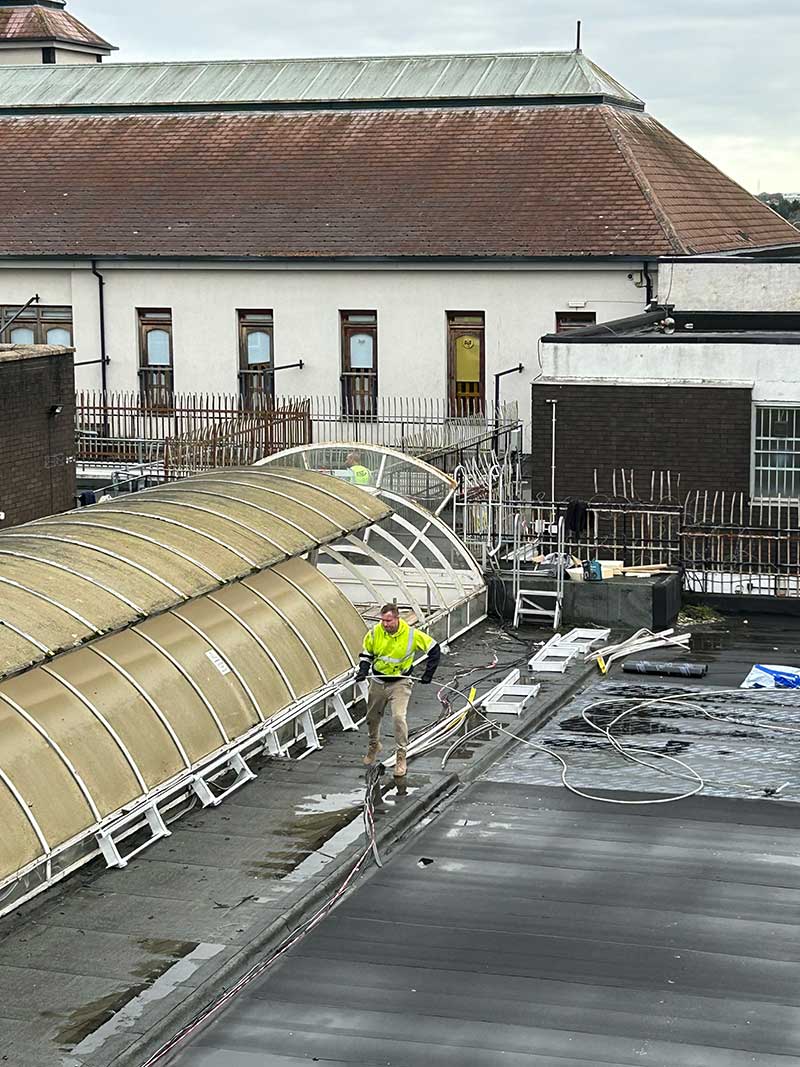
Choosing the right roofing system is one of the most critical decisions in industrial construction and maintenance. Whether you are building a new warehouse, refurbishing an existing factory, or managing an expansive commercial site, the roof plays a pivotal role in protecting assets, maintaining energy efficiency, and supporting long-term structural integrity.
Two principal types of roof systems dominate the industrial landscape: flat and pitched roofs. Both serve the same fundamental purpose—protection from the elements—but their design, performance, and implications for maintenance, drainage, aesthetics, and functional use differ considerably.
This article provides a comparative overview of flat and pitched roofing systems, highlighting their unique features, advantages, limitations, and key considerations to help you determine the most appropriate choice for your industrial facility.
1. Roof Design and Structural Form
Flat Roofs
Flat roofs are not truly flat; they typically feature a slight gradient (around 1 to 5 degrees) to allow water drainage. The design is minimalist, involving fewer materials and simplified geometry, making them quicker to install and easier to access.
Flat roofing is commonly used in large-scale industrial units, such as distribution centres, retail outlets, and production halls, where a vast, uninterrupted ceiling span is needed.
Pitched Roofs
Pitched roofs have a noticeable slope, usually ranging between 15 to 45 degrees. They often comprise two or more sloped sides that meet at a ridge. The steeper gradient allows natural water runoff and is characteristic of traditional architecture.
Pitched roofs are often found on smaller industrial or mixed-use buildings, or in locations where local planning regulations and aesthetics favour a more residential or conventional appearance.
Summary:
-
Flat roofs are simpler in form and well-suited for large, low-rise structures.
-
Pitched roofs provide architectural depth and are advantageous where water shedding and snow loading are key considerations.
2. Drainage and Water Management
Flat Roofs
Drainage is one of the most critical issues in flat roof design. These roofs rely on internal drains, scuppers, or slight slopes directing water toward downpipes. Inadequate drainage can lead to standing water (ponding), which can degrade materials and increase load over time.
Modern flat roofing systems often incorporate tapered insulation or built-in falls to mitigate this, but the risk of pooling remains higher than with pitched alternatives.
Pitched Roofs
Thanks to gravity, pitched roofs are far superior at managing water runoff. Rainwater is efficiently channelled into gutters and downpipes. This reduces the likelihood of water ingress and extends the lifespan of roofing materials.
In regions with high rainfall or frequent snowfall, pitched roofs are generally more reliable due to their self-draining nature.
Summary:
-
Flat roofs require active drainage management and careful installation.
-
Pitched roofs excel in drainage and are naturally resistant to water pooling.
3. Installation Time and Complexity
Flat Roofs
Installation of a flat roof is typically quicker and less labour-intensive. The simple geometry means fewer components and less structural support are needed. It also allows for easier transportation and positioning of materials.
However, because flat roofs must be sealed thoroughly to avoid leaks, precision is vital during the application of waterproof membranes or liquid coatings.
Pitched Roofs
Pitched roofs are more complex to install due to their sloped construction, additional structural framing, and potential need for scaffolding. Roofing tiles, metal sheets, or slates must be individually placed and secured, often extending installation times.
However, this complexity can translate to greater durability in the long run, depending on the quality of workmanship and materials.
Summary:
-
Flat roofs are faster and more straightforward to install but demand precision in waterproofing.
-
Pitched roofs take longer to install but offer long-term reliability if properly constructed.
4. Maintenance and Access
Flat Roofs
Flat roofs are far easier to access and inspect. Whether it’s for routine checks, cleaning gutters, or installing equipment, a flat surface is inherently safer for maintenance personnel.
This is particularly advantageous for industrial buildings that house HVAC systems, solar panels, or skylights on the roof. Accessibility reduces downtime and simplifies inspections.
Pitched Roofs
Pitched roofs are more difficult and hazardous to access. Safety gear and specialist contractors are often needed for even basic inspections. This increases maintenance complexity and could delay minor repairs during inclement weather.
Snow removal and debris clearing can also be more time-consuming on steep slopes.
Summary:
-
Flat roofs are easier and safer to maintain.
-
Pitched roofs require more care and equipment for maintenance activities.
5. Use of Roof Space
Flat Roofs
A significant benefit of flat roofs is the potential to utilise the surface area. Many industrial buildings use flat roofs for:
-
Installing solar panels or wind turbines
-
Mounting HVAC and mechanical units
-
Creating roof gardens or green roofs for environmental benefits
-
Supporting skylights or access hatches
In urban areas, flat roofs can even serve as recreational or break areas for staff, depending on safety provisions.
Pitched Roofs
Pitched roofs offer limited usable surface space. Equipment installation is more difficult due to the slope and may require additional structural support or anchoring mechanisms.
However, the interior volume under a pitched roof can sometimes be repurposed for storage or mezzanine levels, depending on building design.
Summary:
-
Flat roofs offer flexible, accessible space for equipment and innovation.
-
Pitched roofs limit surface use but may provide internal storage potential.
6. Energy Efficiency and Insulation
Flat Roofs
Modern flat roof systems can be highly energy efficient when properly insulated. Warm deck systems, where the insulation is placed above the structural deck, reduce thermal bridging and heat loss.
That said, flat roofs are more exposed to direct sunlight and may overheat in summer without proper ventilation or reflective materials.
Pitched Roofs
Pitched roofs naturally promote better airflow and thermal circulation. Their angled shape reduces solar gain in summer and creates space for attic or loft insulation, which adds another thermal buffer.
Pitched roofs generally perform better in maintaining consistent internal temperatures year-round.
Summary:
-
Flat roofs can be energy efficient with the right insulation but are vulnerable to heat gain.
-
Pitched roofs support natural airflow and stable internal climate regulation.
7. Lifespan and Durability
Flat Roofs
The lifespan of a flat roof depends largely on the material used—EPDM, TPO, modified bitumen, or felt systems all vary. With proper installation and maintenance, modern flat roofs can last 20 to 30 years.
However, they are more susceptible to weather-related wear, particularly from standing water and UV exposure.
Pitched Roofs
Pitched roofs tend to last longer, especially when built with robust materials like clay tiles, metal sheeting, or slate. Lifespans of 40 to 60 years are common, and well-maintained pitched roofs can exceed that.
They also weather storms better due to their aerodynamic shape.
Summary:
-
Flat roofs offer a decent lifespan but need consistent upkeep.
-
Pitched roofs are generally more durable and long-lasting.
8. Aesthetic and Planning Considerations
Flat Roofs
Flat roofs are visually discreet and support contemporary industrial design. In some planning zones, they may be preferred for preserving sightlines or minimising building height.
However, in heritage zones or areas with traditional architecture, flat roofs may be restricted or discouraged.
Pitched Roofs
Pitched roofs often align with local architectural styles and may be more acceptable in semi-rural or conservation areas. They provide a familiar silhouette and contribute positively to the building’s character.
They can also support branding or signage more effectively due to their vertical surfaces.
Summary:
-
Flat roofs suit modern, minimal design preferences.
-
Pitched roofs are more adaptable to traditional planning requirements and visual harmony.
Which One Is Right for You?
The decision between a flat or pitched roof system depends on several factors:
| Consideration | Preferred System |
|---|---|
| Large-scale industrial units | Flat Roof |
| Areas with high rainfall or snow | Pitched Roof |
| Fast installation | Flat Roof |
| Long-term durability | Pitched Roof |
| Roof-mounted equipment | Flat Roof |
| Architectural conformity | Pitched Roof |
| Ease of maintenance | Flat Roof |









